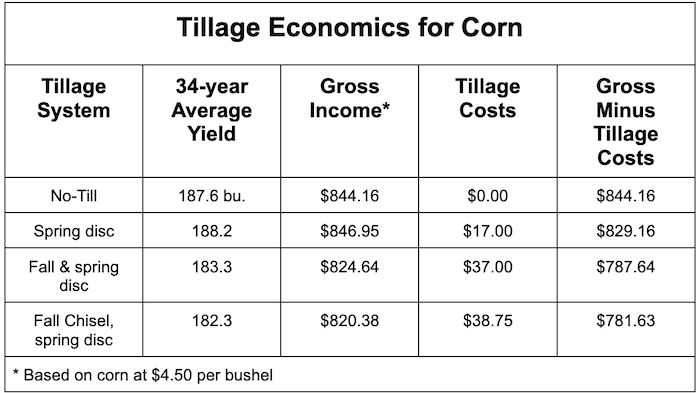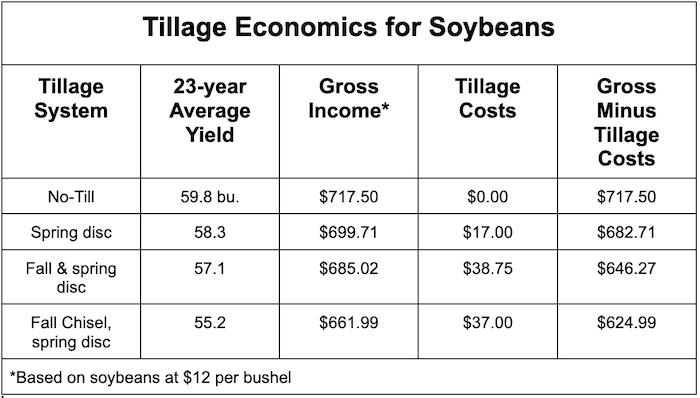.png)
Over the years, No-Till Farmer has reported on several continuous long-term tillage practice trials. These include:
- The 62-year trials at Ohio State University’s Agricultural Research and Development Center at Wooster.
- The 54-year trials at Southern Illinois University’s Belleview Research Center in Belleville.
- The 54-year trials conducted at the University of Kentucky’s Spindletop Research Farm in Lexington.
- The University of Nebraska’s Rogers Memorial Farm plots that have been conducted since 1981
Each of these four long-term studies point out the many benefits of no-tilling.
Just recently, the University of Missouri released data on a 34-year tillage study for corn and a 23-year study regarding tillage systems for soybeans that definitely show the many benefits of no-tilling.
34 Years of No-Till Corn Benefits
The Missouri study demonstrates that data conducted over 34 years shows that no-till offers the highest return of any tillage system for corn. This data comes from trials held at the University of Missouri Graves-Chapple Extension and Education Center at Rock Port in northwestern Missouri. Four tillage systems were compared: fall and spring disc; spring disc; no-till; and fall chisel and spring disc.
Each plot included eight 30-inch rows that were 250 feet long. For 2023, the corn plots were planted at a 32,000 per acre plant population into soybean residue on April 18. Last fall’s harvest took place on October 10.
The application of seed, planting, fertilizer, herbicides and harvesting were the same for all four tillage practices.
The 2022 growing season had been dry, as was the 2023 corn growing period. Rainfall during the 2023 growing season was sparse and below average, and temperatures had large swings.
The no-till corn plot had the highest yield at 218.8 bushels per acre while the fall chisel and spring disc plot was the lowest-yielding system with 206.7 bushels per acre.
Over the 34 years, gross income with $4.50 per bushel corn minus the cost of tillage indicated that the no-till plots grossed $14.21 per acre more than the spring disc plots, $62.52 per acre more than the fail chisel and spring disc system and $56.51 per acre more than the fall and spring disc plots.
When tillage costs are subtracted from the gross income, the data shows a $15 to $62.53 per acre advantage for no-tilled corn.
With 900 acres of corn, that results in an advantage of $56.27 for no-tilling corn compared to the fall chisel and spring disc system.
“History has shown that during weather patterns like this, no-till usually has the highest yield because it allows better water infiltration,” said Jim Crawford, the director of the Graves-Chapple Center. “Allowing the roots to chase water deep into the profile benefits the plants when the hot and dry summers arrive.” No-tilling also helps moderate swings in soil temperatures.
Over 34 years, the data show the spring disc system had the highest corn yield of 188.2, followed closely by no-till at 187.6. bushels per acre.
No-Till Soybeans Also Win
The soybean research has been conducted for 23 years. Over that time, no-till had the highest average yield. It averaged 59.8 bushels followed closely by the spring disc system at 58.3 bushels per acre per year.
When tillage costs with soybeans are subtracted from gross income, the data shows a $34.79 to $92.51 benefit for no-tilling soybeans.
With 900 acres of soybeans, this leads to a no-till advantage for no-till of $83,259 when compared to the fall chisel and spring disc tillage system.
Each plot consisted of eight 30-inch rows that were 250 feet long. In 2023, the plots were planted on May 10 with a 138,500 per acre population seeded into corn residue. Harvest was conducted on November 13 with yields measured from the center four rows of each plot for both corn and soybeans.
In 2023, the no-till plots had the highest yield at 63 bushels per acre. The fall chisel and spring disc was the lowest-yielding system with 55.9 bushels per acre.
For the 23-year period, data shows that with soybeans priced at $12 per bushel, no-till grossed $34.78 per acre more than the spring disc plots, $92.51 per acre more than with the fall and spring disc system and $71.22 per acre more than the fall and spring disc plots.
“The biggest aspect of no-till over the years is the financial savings since there are no tillage costs,” Crawford says. “The application of fertilizer, herbicides, seed, planting and harvesting were the same for each of the four tillage systems.”
When dealing with drought conditions, the data shows that no-till usually has the top yield because it allows better water filtration. “Allowing the roots to chase water deep in the profile benefits the plants when the hot and dry days of summer arrive,” Crawford says.
Over 34-year period for corn and the 23-year time frame with soybeans, the real no-till advantage is the lower labor and equipment costs due to fewer trips across the field, making it the most profitable system for both corn and soybeans.








